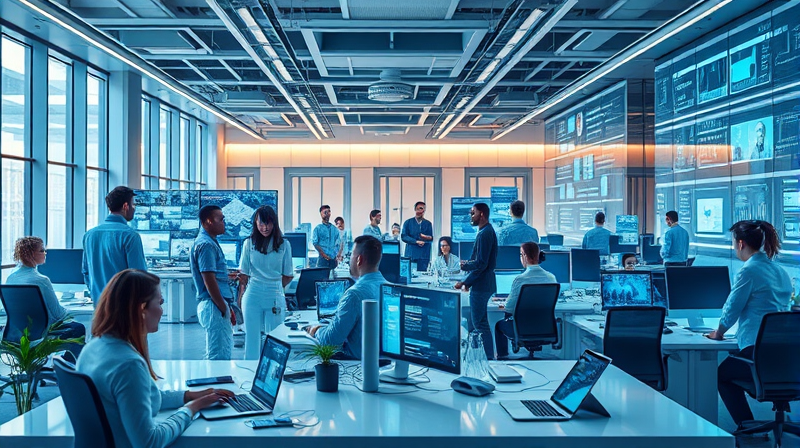In today’s rapidly evolving digital landscape, businesses are compelled to reimagine the way they work in order to boost productivity and foster innovation. Over the past few years, advancements in technology and shifts in work models have not only disrupted traditional practices but have also paved the way for a truly integrated digital workspace. The future of work is agile, collaborative, and deeply rooted in a culture that embraces both the power of artificial intelligence and the human need for connection.
Amidst the backdrop of constant change and uncertainty, leaders and employees alike are finding renewed inspiration in the opportunities that modern digital platforms offer. By streamlining digital workspaces, organizations not only secure a competitive advantage but also empower their teams with the tools and flexibility required to thrive in an era of hybrid work.
Key Trends Shaping the Digital Workspace
Hybrid Work as the New Standard: The increasing adoption of hybrid work models has transformed how organizations operate. With many employees splitting their time between remote locations and traditional office spaces, flexibility is essential to fostering both autonomy and collaboration. This balance minimizes long commutes while increasing personal productivity. As teams come together in centralized environments for critical planning and strategy sessions, companies realize the full benefits of reduced overhead costs, enhanced job satisfaction, and improved employee retention.
Additionally, the hybrid model supports diverse workflows, ensuring that teams with varying needs and preferences find a comfortable balance. This approach results in streamlining communications and maintaining a well-connected workforce regardless of physical location.
AI and Automation: Catalysts for Efficiency
At the heart of digital transformation lies the integration of artificial intelligence and automation. These technologies are not just buzzwords but are integral parts of a modern workspace that prioritizes efficiency. Businesses can now automate repetitive processes such as scheduling, reporting, and data analysis. This frees up human capital to focus on creative and strategic tasks which, ultimately drive business growth.
AI-driven tools can also revolutionize how teams collaborate, allowing for seamless integration of smart assistants and real-time data processing that supports agile decision-making. The benefits extend to error reduction, faster response times, and more personalized customer experiences, which all contribute to a dynamic work environment.
Unified Communication and Employee Experience Platforms
Unified communication solutions are at the forefront of the modern digital workspace. These platforms consolidate video conferencing, messaging, and VoIP into one comprehensive system. When communication is streamlined, teams can easily share ideas and resources, which leads to enhanced collaboration and coordination. Efficiency is maximized when employees do not have to switch between multiple applications to stay connected.
Furthermore, employee experience platforms that integrate analytics and personalized support elevate the overall work environment. They enable managers to track engagement, meet employee needs, and ultimately foster a culture of inclusion and continuous improvement.
Digital Twins and Workforce Management
The emergence of digital twins has created new avenues for optimizing workplace designs and operational efficiency. Digital twins offer realistic simulations of office layouts and team dynamics, allowing administrators to test different configurations and make data-driven decisions. This trend is especially significant as organizations plan for future growth and adapt to ever-changing workforce requirements.
By leveraging digital twin technology, businesses can preemptively identify potential inefficiencies and address them before they impact productivity. This approach not only results in cost savings but also ensures that working environments remain agile and supportive of the needs of contemporary teams.
Emphasis on Security and Cloud Flexibility
In a digital age where endpoints and remote access points are ubiquitous, security takes on an even more central role. Organizations must ensure robust endpoint security and adopt cloud solutions that offer both flexibility and enhanced control. Whether choosing a public or private cloud deployment, the key is to balance agility with the rigor of security protocols.
Security measures have become indispensable as more data is generated and transmitted via interconnected networks. The right security framework not only protects sensitive information but also instills confidence within teams, allowing them to work without distractions or fears of breaches.
Best Practices to Streamline Your Digital Workspace
Successful digital transformation is built on a foundation of well-defined strategies and actionable best practices. To truly streamline your digital workspace, consider implementing these approaches:
- Adopt AI-powered tools: Leverage automation to handle repetitive tasks and focus on high-value activities that foster innovation.
- Implement unified communication platforms: Centralize messaging, calls, and video conferencing to reduce friction and seamlessly connect remote teams.
- Prioritize employee experience: Invest in tools that enhance engagement and provide personalized support tailored to individual needs.
- Embrace hybrid work and flexible workspaces: Create workplace policies and use spaces that cater to both in-office and remote workers to promote an adaptive work environment.
- Focus on security and resiliency: Employ advanced security frameworks and evaluate cloud options that ensure data protection without compromising agility.
By adopting these measures, companies can build a resilient digital infrastructure that not only meets current demands but is also prepared for the challenges and opportunities that the future holds.
The Road Ahead
The evolution of the digital workspace is a journey rather than a destination. As organizations continue to incorporate digital innovations into their work environments, the result is a more agile, efficient, and secure business ecosystem. Progressive leaders understand that investing in digital transformation is essential for sustainable business success. By embracing a comprehensive strategy that involves AI, unified communications, and robust security measures, companies are poised to unlock significant benefits.
Moreover, a streamlined digital workspace not only drives operational efficiency but also cultivates a culture of trust and empowerment among employees. When people are provided with the right tools and resources, their potential for creative problem solving and collaboration expands dramatically.
Looking into the future, organizations that prioritize the enhancement of their digital work environments will stay ahead of the curve and secure long-term growth. The digital workspace is more than a hub for remote tasks—it is a dynamic arena that encourages innovation, nurtures talent, and prepares businesses for the unpredictable landscape of tomorrow.
By taking bold steps today to streamline digital processes and reinforce security, companies can transform challenges into opportunities for success. This commitment to innovation and adaptability is what will ultimately produce a thriving digital ecosystem where both employees and businesses can excel.








